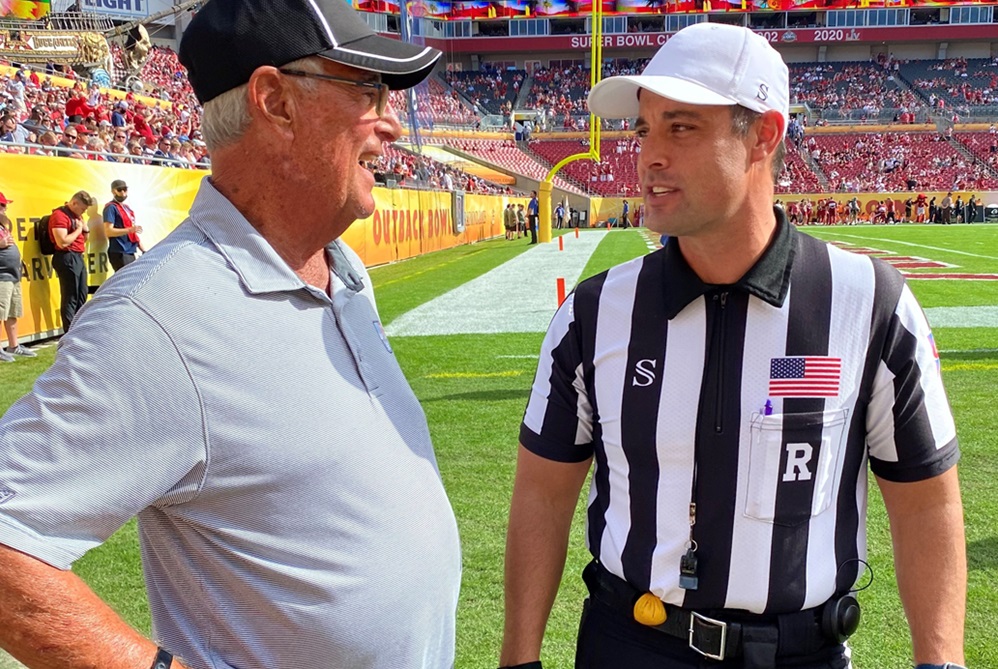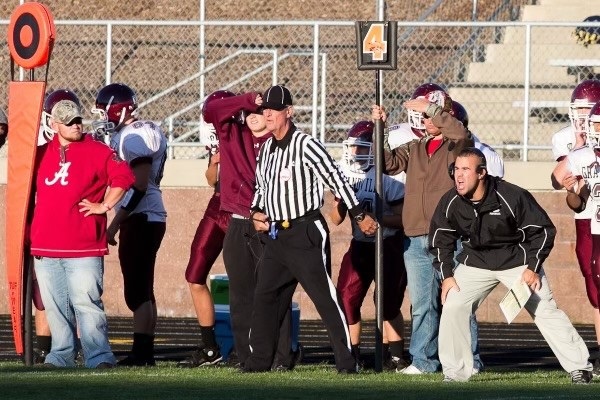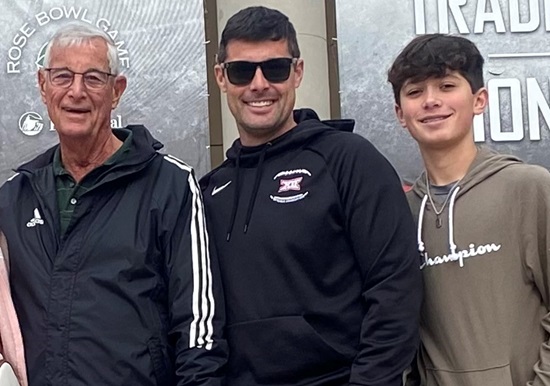
Inside Selection Sunday: Mapnalysis '13
October 28, 2013
By Geoff Kimmerly
Second Half editor
At the end of the day – Sunday, in this case – the 2013 MHSAA football playoff field was determined based on a set of numbers we began working with long before the first kickoff of this season.
So to kick off our discussion of how some of the 2013 playoff-selection decisions were made, here are a few numbers that might boggle the mind – or at least surprise:
- A total of 3,111 high school results were used in determining this season’s field – 2,978 for 11-player and 133 for 8-player games.
- We inputted and then followed the schedules for 623 MHSAA teams.
- We also inputted and followed weekly the schedules for 50 teams from surrounding states and Ontario that played at least one game against one of our MHSAA schools.
- We worked through complicated maneuverings made necessary by seven teams playing a mix of 11 and 8-player games, plus two more teams that played a mix of varsity and junior varsity opponents.
- And by Sunday morning we ended up with a few more numeric rarities: only 225 automatic qualifiers, the fewest since the current playoff system was introduced in 1999, and also an uneven number of at-large bids from our four classes because only six Class D teams reached the number of victories needed to be considered. (This was balanced by taking more at-large qualifiers from Classes A, B and C.)
And that was just the start of one of our most exciting days of the school year.
Following are more details. First, I explain some of the history of the MHSAA playoffs – I’ve lifted this in part from our 2012 report, so skip ahead if you’ve already got that down. Next, I touch on five themes that emerged as we built the brackets for this season’s tournament.
The process
Our past: The MHSAA playoff structure – with 256 teams in eight divisions, and six wins equaling an automatic berth (or five wins for teams playing eight or fewer games) – debuted in 1999, as mentioned above. An 8-player tournament was added in 2011, resulting in nine champions total when November is done.
That’s a long way from our start. The first playoffs were conducted in 1975 with four champions. Four more football classes were added in 1990 for a total of eight champions each fall. Through 1998, only 128 teams made the postseason, based on their playoff point averages within regions (four for each class) that were drawn before the beginning of the season. The drawing of Districts and Regions after the end of the regular season did not begin until the most recent playoff expansion.
In early years of the current process (or until the middle of the last decade), lines were drawn by hand. Dots representing qualifying schools were pasted on maps, one map for each division, and those maps were then covered by plastic sheets. Districts and Regionals literally were drawn with dry-erase markers.
Our present: After a late Saturday night tracking scores, we file in as the sun rises Sunday morning for a final round of gathering results we may still need (which can include making a few early a.m. calls to athletic directors). Then comes re-checking and triple-checking of enrollments, what schools played in co-ops, some records and more before the numbers are crunched and the fields are set.
Those 256 11-player teams are then split into eight equal divisions based on enrollment, and their locations are marked on digital maps that are projected on wall-size screens and then discussed by nearly half of the MHSAA staff plus a representative from the Michigan High School Football Coaches Association. Only the locations themselves are marked (by yellow dots) – not records, playoff point averages or names of the schools or towns. In fact, mentions of those are strictly prohibited. Records and playoff points are not part of the criteria. Matchups, rivalries, previous playoff pairings, etc. also DO NOT come into play. The same process is followed for organizing the 8-player bracket.
Observations and answers: 2013
This doesn’t happen overnight: Preparation for selecting the MHSAA playoff field begins long before the first kickoff of fall, much less the first practice. We load schedules for all 600-plus varsity teams during the summer, and many schedules remain fluid right up until the first Friday of the season – and this fall, a few weren’t settled until Week 2 or 3.
This summer as in some past we also worked through schools closing (Inkster, Saginaw Buena Vista, Detroit Northwestern, Flint Northern), and others deciding in mid-July and early August they would not field teams because of a lack of players.
Sometimes we have to take odd paths to find scores for these games. The last 11-player score to be added to our data this regular season came in as a result of tweeting the sports anchor of a Wheeling, W.Va., television station. Our last 8-player score came in via email from a Wisconsin athletic director at 10:30 Saturday night. Thankfully, we get plenty of assistance from some of our friends in the field, who keep an eye on the data and alert us when something appears missing or incorrect.
Win and advance: This season’s list of 5-4 teams includes a number of heavy hitters that did not receive at-large bids – East Grand Rapids, Utica Eisenhower, Orchard Lake St. Mary’s and Flint Powers Catholic to name a few. All were solid teams and played strong competition. All missing the playoffs likely raised some eyebrows.
But we have to take a look at this from a statewide view. There admittedly can be some argument about what schools qualified for the 226-256 spots in the field – but the important part is that 225 qualified because they all met the minimum win requirement. A playoff is simply that – it decides a champion based on teams winning. For some it’s harder to pile wins, of course, because they play in tough leagues. But the winners of those leagues are in the field – and surely will credit that tough road with getting them prepared to now play the state’s best.
Geography rules: This long has been rule number one for drawing MHSAA brackets in any sport, and is a repeat as well for those who have read this report the last two Octobers. Travel distance and ease DO come into play. Jumping on a major highway clearly is easier than driving across county-wide back roads, and that’s taken into consideration.
Also, remember there’s only one Mackinac Bridge and hence only one way to cross between peninsulas – and boats are not considered a possible form of transportation. When opponents from both peninsulas will be in the same District, distance to the bridge is far more important than as the crow flies.
The best example of this comes this season in Division 5. Grayling clearly is east of both Kingsley and Kalkaska – but also sits on I-75, while those two do not. So while those more western teams are geographically closer to Houghton, Menominee and Kingsford from the Upper Peninsula, we instead paired the three U.P. teams with Grayling because being on a main highway made for a shorter trip. The trip to Grayling for any of those U.P. teams would be 36 miles shorter to Grayling than Kingsley and 13 miles shorter to Grayling than Kalkaska.
Sometimes it’s where the points aren’t: Sure, it would be best-case scenario to have perfect sets of eight dots split into four quadrants from Calumet to Bedford. But generally that doesn’t occur. “Dots determine the map” is a common phrase heard here during this selection process, but that works the other way as well. If there are no qualifiers in a division from a specific area of the state – see Division 1, with none south of Holland or west of the greater Lansing area – there’s no choice but to create the unusual Regional Final possibility of Traverse City West vs. Brighton. Brighton is simply closer to the west side of the state than our other options.
Border to border vs. coast to coast: Should Regions be grouped north to south or east to west? There isn't a right or wrong answer – it just depends on that set of dots.
Whenever we have Upper Peninsula teams in a division, they’ll be grouped with those from the northernmost points of the Lower Peninsula for a District. The next northernmost schools will be grouped into a District, and together those eight will form a Region.
But the tough decision comes with the other six Districts. Look at this season’s Division 5 map: Six Districts are grouped south of U.S. 10 with three near or west of U.S. 127 and three east of that highway, which runs through the center of the Lower Peninsula. We grouped the two southwestern Districts into a Region and the two southeastern Districts into a Region – leaving a final Region that stretches from Muskegon on Lake Michigan to Almont, about 35 miles west of Lake Huron.
That’s a haul. But it’s also the best of our possible compromises. We could’ve instead paired regions that would’ve stretched from Hopkins to Monroe – only 19 fewer miles in distance than Muskegon Oakridge to Almont, but a scenario that could’ve created travel increases for a number of additional teams. Another option included a possible trip from Detroit University Prep to Freeland, which also would take more than two hours.
Bottom line – it’s been written here before – we pour all we have into this process, asking questions often more than once until we come up with a consensus. We do appreciate the arguments that arise once brackets are released to the public: The discussions are proof of how much players, coaches and fans care – and often show us new ways we can look at a system that’s now 15 years old.
But we must remember that the good news is the tournament is still set up to reward nine champions over the next five weeks, and five schools – Auburn Hills Oakland Christian, Coldwater, Detroit Allen, Eaton Rapids and Muskegon Mona Shores – will be competing for those titles for the first time.
It’s not so much how the tournament starts as how it ends. And we’re preparing for nine more memorable conclusions.
PHOTO: Each collection of grouped dots is a District on this season's Division 3 playoff map.

VanderVelde Officiating Tree Branches Into 2nd Generation, Top-Tier College Football
By
Steve Vedder
Special for MHSAA.com
February 28, 2025
Mike VanderVelde always knew the apple wasn't going to fall far from the tree.
The longtime West Michigan football and basketball official correctly guessed that his son, Michael, who had accompanied his father to countless Friday night football games before he was even out of elementary school, would eventually pick up the family mantle of officiating. VanderVelde said he saw in his young son many of the key attributes an official must possess: a keen eye for details, an overwhelming desire to improve, patience and a love of sports.
Put it all together, and VanderVelde has seen his son evolve into one of the nation's top NCAA football officials.
"I think it was just like with any kid, he liked the competition," said Mike VanderVelde, who retired three years ago at the age of 78 after officiating in the Grand Rapids area for 61. "I guess it would be crazy to say now, but even then there was something about Michael that was going to make him a good official. It wasn't (following) me."
Michael, a Grandville High School and Hope College graduate, has gone from working middle school football games to make extra money in college to officiating eight college bowl games, including this year's Sugar Bowl national quarterfinal Jan. 2 in New Orleans and the semifinal Jan. 9 at the Orange Bowl in Miami. VanderVelde's first bowl game was the 2017 Bahamas Bowl, and he also officiated the 2024 Rose Bowl, the national semifinal between eventual champion Michigan and Alabama.
 Before reaching those heights, Michael said some of his earliest sporting moments came when he was a ball boy jogging along the sideline while his father was working on the field. VanderVelde figures he was barely 8 years old, but he remembers being taught by his father to pay attention to detail. He also considers his father a major influence in his decision to pursue football officiating at the highest level.
Before reaching those heights, Michael said some of his earliest sporting moments came when he was a ball boy jogging along the sideline while his father was working on the field. VanderVelde figures he was barely 8 years old, but he remembers being taught by his father to pay attention to detail. He also considers his father a major influence in his decision to pursue football officiating at the highest level.
"I'd buy that, absolutely. I loved spending time with my dad on Friday nights. That was definitely a common bonding time,” Michael VanderVelde said. “I'd see the smile on his face and see his passion for football. I'd see subtle little hints, and I'd pick up on that. The seed was definitely planted.”
Even as a youngster who was yet to see middle school, Michael said he understood the necessity of being where he was supposed to be as a ball boy. It was one of his first lessons in accepting responsibility and that actions had consequences.
"I would hand the ball to the umpire and pay attention to the game, and do what they needed me to do," he said. "And then I'd hang out with the crew after the games. Just being around the game and watching and being close to it, I loved it."
Both VanderVeldes entered officiating on the ground floor. Mike began doing YMCA fifth and sixth grade and church league basketball games at Grand Rapids' Franklin Park during the 1950s. He eventually graduated to working about 75 high school football and basketball games a year along with officiating Great Lakes Intercollegiate Athletic Conference and Michigan Intercollegiate Athletic Association football games. VanderVelde also coached football, tennis and junior high basketball at Wyoming Kelloggsville High School for 30 years.
"I've always been involved with athletics; I've really enjoyed it," Mike said. "I always thought of (officiating) as a challenge. I wanted to see what I could do. It intrigued me, trying something new. It just clicked with me, and I kept going and I never really stopped."
The younger VanderVelde also started at the youngest levels, officiating fourth through sixth-grade football games before he graduated from high school in 2003. Then to make extra money while in college, VanderVelde took on freshman, junior varsity and his first varsity football game at Saranac. He eventually worked high school basketball games before moving to Colorado and doing Southland Conference games for three years beginning in 2013. VanderVelde went on to work for three years in the Mountain West Conference and now officiates Big 12 games while living in Louisiana.
While many fans often fail to grasp the pressures an official faces while working major college football bowl games, VanderVelde said he's thrilled to reach that elite level of officiating.
 "It's a blast," he said. "To be there with other officials and doing things like working with the replays, getting the calls correct, 11 on 11 football and being on the biggest stage, I love it."
"It's a blast," he said. "To be there with other officials and doing things like working with the replays, getting the calls correct, 11 on 11 football and being on the biggest stage, I love it."
As for the recently completed college season, VanderVelde was honored that the NCAA – in a rare break from tradition – chose his crew to work back-to-back Notre Dame games in the Sugar and Rose Bowls. The NCAA typically will not assign the same crew to the same team two weeks in a row. It was an extraordinary gesture signaling the high esteem in which the crew is held, not only by the NCAA but with the blessing of all teams involved.
"It's tough to work back-to-back games like that, but I think the crew did an excellent job," he said. "There was no controversy, and I think we felt comfortable being assigned those games."
Considering his officiating success, VanderVelde said there is one step yet to take, one more hurdle to leap: the NFL. VanderVelde. who works United Football League games in the spring, has been part of the league's Mackie Development Program for the last two years. He's already worked Hula Bowl games and would gladly consider moving along to working on Sundays.
"I'd love to have that opportunity if it was ever presented to me," he said. "It'd be cool, but there are no guarantees. You know that snap by snap, you're only as good as your last game. But it's something I'd like to do some day.
"In football all you can do is look at your next assignment and try to do it well. It's exciting, but you're always trying to go on to the next game without a hitch."
PHOTOS (Top) Longtime MHSAA official Mike VanderVelde, left, and son Michael share a moment during Michael’s officiating assignment at the 2021 Outback Bowl in Tampa Bay, Fla. (Middle) Mike VanderVelde officiates a Grandville High school game. (Below) From left: Mike VanderVelde, Michael VanderVelde, and Michael’s son Hayden. (Photos provided by the VanderVelde family.)

